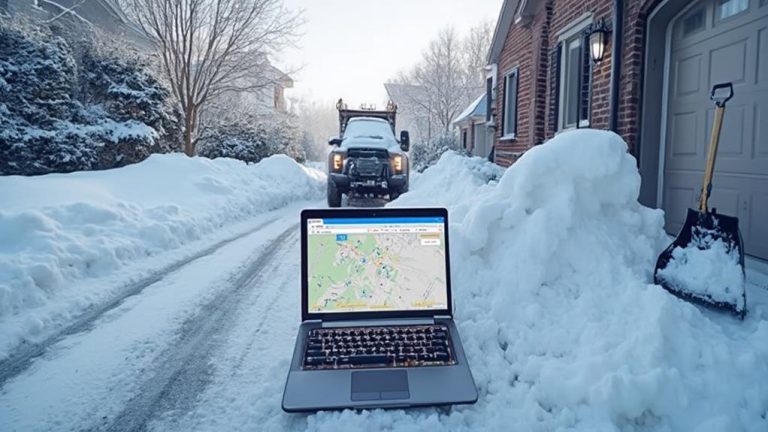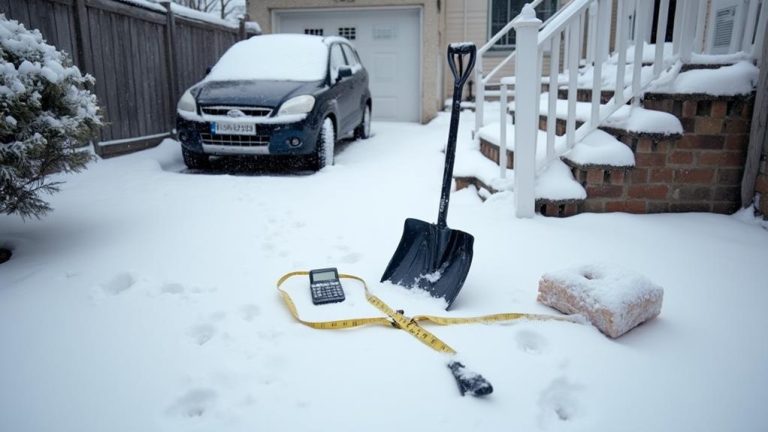Salt and de-icing techniques are vital for winter road maintenance, employing salt’s chemical properties to lower water’s freezing point. When you apply salt to icy surfaces, it dissolves into ions that disrupt ice crystal formation, creating a brine solution that melts existing ice and prevents new ice from forming. This process continues to work at temperatures below water’s normal freezing point, enhancing road safety and improving traction. Understanding the science behind salt’s effectiveness, including concepts like freezing point depression and the eutectic point, allows for more efficient and environmentally conscious de-icing practices. Exploring these techniques further reveals their impact on winter road management.
Snow Plowing Highlights
- Salt lowers water’s freezing point, preventing ice formation and melting existing ice on roads and sidewalks.
- Salt creates ions that disrupt ice crystal formation, allowing de-icing at temperatures below water’s normal freezing point.
- The eutectic point of salt-water mixtures occurs at -21.1°C with 23.3% salt concentration, optimizing de-icing efforts.
- De-icing techniques enhance road safety by increasing traction, reducing accidents, and improving visibility during winter conditions.
- Salt-based and alternative de-icing products are used based on temperature and environmental considerations for effective snow management.
Basic Chemistry of Salt Melting
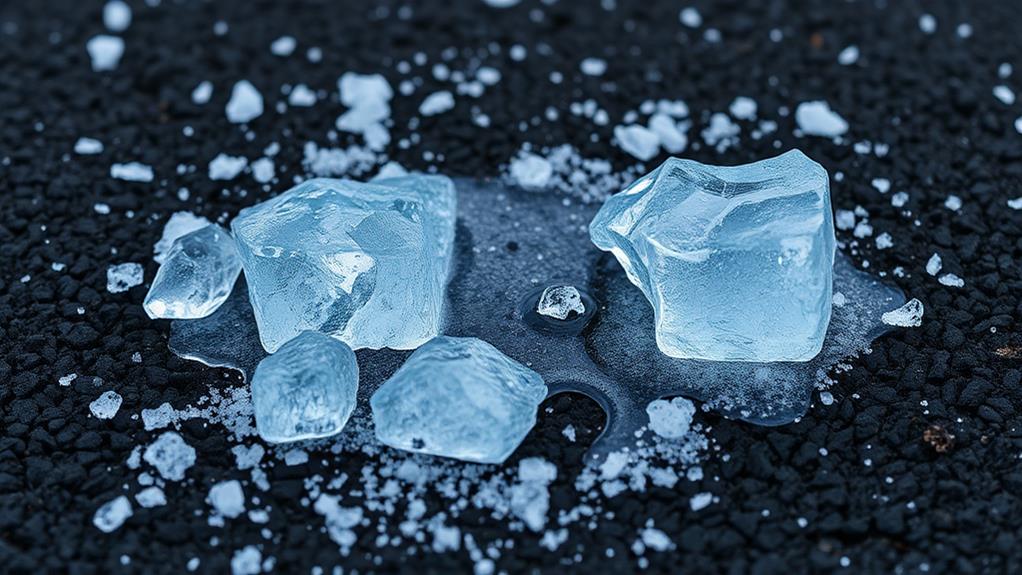
Snow Plow Solutions offers thorough de-icing services that leverage the basic chemistry of salt melting to keep roads, parking lots, and walkways safe during winter weather. Our expert team understands the science behind how salt lowers the freezing point of water, preventing ice formation and melting existing ice.
By using technology-driven solutions and innovative techniques, we maximize efficiency and minimize environmental impact. We use a variety of salt-based and alternative de-icing products, carefully selected based on temperature conditions and environmental considerations.
How Salt Lowers Freezing
Delving into the chemistry behind salt’s ice-melting prowess, it’s vital to comprehend how this common substance lowers the freezing point of water. When you add salt to water, it dissolves and separates into positively charged sodium ions and negatively charged chloride ions. These ions interfere with water molecules’ ability to form ice crystals, disrupting the orderly arrangement needed for freezing. As a result, the temperature at which the solution freezes is lower than that of pure water.
This phenomenon, known as freezing point depression, is directly related to the concentration of salt in the solution. The more salt you add, the lower the freezing point becomes, up to a certain limit. It’s essential to recognize that salt doesn’t actually melt ice; instead, it prevents water from freezing and encourages existing ice to melt at lower temperatures. This principle is why salt is so effective in de-icing roads and sidewalks. By lowering the freezing point of water on these surfaces, you’re creating an environment where ice is less likely to form or persist, ensuring safer conditions for vehicles and pedestrians alike.
Ion Disruption Process
To fully grasp how salt melts ice, we need to explore the ion disruption process at the molecular level. When you apply salt to ice, it dissolves into positively charged sodium ions and negatively charged chloride ions. These ions interfere with the water molecules’ ability to form stable ice crystals by disrupting their hydrogen bonds. As a result, the ice begins to melt, creating a brine solution that further lowers the freezing point of the surrounding ice.
This ion disruption process is pivotal for effective de-icing, as it allows the salt to continue melting ice even at temperatures below water’s normal freezing point. The concentration of ions in the brine solution determines how low the freezing point can be depressed. As you increase the salt concentration, you’ll achieve a lower freezing point, up to a certain limit. This is why road crews often use a mixture of salt and other de-icing chemicals to enhance the ion disruption process and improve overall effectiveness. Understanding this molecular interaction helps you appreciate the science behind salt’s role in snow and ice management, ensuring safer winter conditions for your community.
Eutectic Point Explained
Understanding the eutectic point is indispensable when discussing salt’s ice-melting capabilities. This pivotal concept in chemistry refers to the temperature at which a mixture of substances, such as salt and water, freezes or melts as a single entity. When you apply salt to ice, it lowers the freezing point of water through a process called freezing point depression. As the salt dissolves, it creates a brine solution that has a lower freezing point than pure water.
The eutectic point for a salt-water mixture occurs at approximately -21.1°C (-6°F), with a salt concentration of 23.3%. At this point, the solution can’t be made to freeze by adding more salt or lowering the temperature further. This knowledge is essential for snow and ice management professionals, as it helps determine the most effective salt concentrations and application rates for various weather conditions. By understanding the eutectic point, you’ll be able to optimize your de-icing efforts, ensuring efficient ice removal while minimizing salt usage and potential environmental impacts. This scientific approach to ice management allows for more precise and cost-effective snow removal services.
Benefits
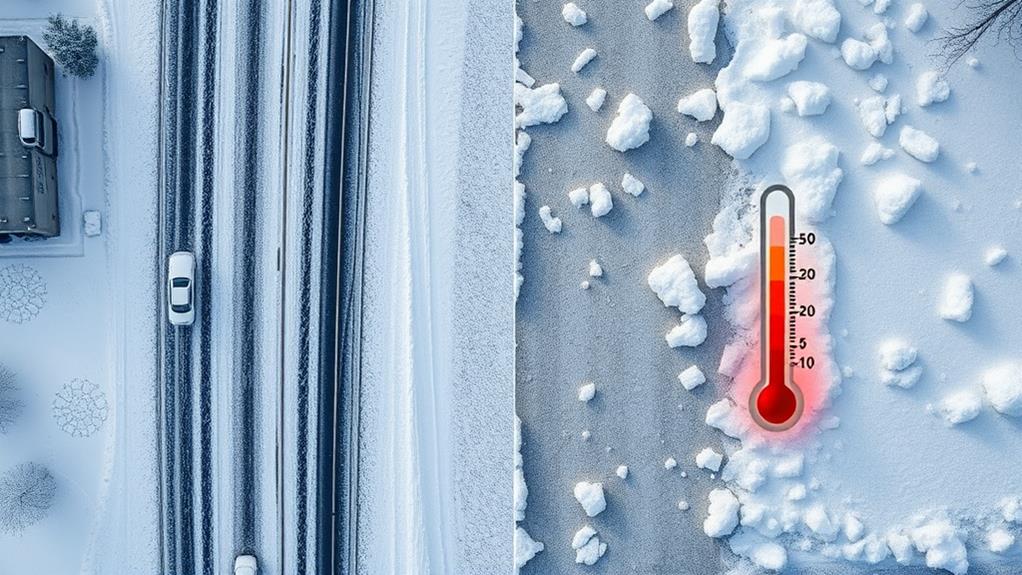
When you consider the benefits of salt and de-icing techniques, you’ll find they extend far beyond simply clearing snow and ice from roads. These methods considerably enhance road safety by improving traction and reducing accidents, while also extending the lifespan of pavement by preventing freeze-thaw cycles that can cause cracks and potholes.
Additionally, modern de-icing techniques often incorporate environmentally friendly alternatives and precise application methods, which not only reduce the overall environmental impact but also prove to be a cost-effective approach to winter maintenance for municipalities and property owners alike.
Utilizing commercial snow plowing services can further enhance these advantages by ensuring timely and thorough snow removal, minimizing disruptions for businesses during snowy conditions.
Enhanced Road Safety
The primary benefit of salt and de-icing techniques is enhanced road safety during winter conditions. When you’re driving on icy or snow-covered roads, you’ll appreciate the increased traction and reduced risk of accidents that these methods provide. Salt lowers the freezing point of water, causing ice to melt and preventing new ice from forming, which means you’ll have a clearer path as you navigate winter streets.
De-icing techniques, such as pre-treating roads with brine solutions or applying salt during snowfall, help maintain safe driving conditions throughout winter storms. You’ll notice improved visibility as salt prevents snow from bonding to the road surface, reducing spray from other vehicles. These methods also allow for faster snow removal, ensuring you can reach your destination safely and on time.
Additionally, the use of salt and de-icers helps emergency vehicles respond more quickly to critical situations, potentially saving lives in your community. By implementing these techniques, road maintenance crews create a safer environment for all drivers, pedestrians, and cyclists, allowing you to feel more confident and secure as you travel during winter months.
Extended Pavement Lifespan
Salt and de-icing techniques offer more than just immediate safety benefits; they also contribute to extending pavement lifespan. When you use these methods, you’re not only ensuring safer roads for your community but also investing in the longevity of your infrastructure. By preventing the formation of ice and reducing freeze-thaw cycles, you’re minimizing the stress on road surfaces, which can lead to cracking, potholes, and other forms of deterioration.
The application of salt and de-icing agents helps to lower the freezing point of water, preventing it from bonding with the pavement surface. This reduction in ice formation means less expansion and contraction of water within the pavement structure, which is a primary cause of road damage during winter months. Additionally, by keeping roads clear of snow and ice, you’re reducing the need for aggressive plowing techniques that can cause surface abrasion. The use of pre-wetting and anti-icing strategies further enhances this protective effect, creating a barrier between the pavement and winter precipitation. By implementing these techniques, you’re not only maintaining safer roads but also preserving your community’s investment in its transportation infrastructure, potentially saving significant costs on repairs and replacements in the long run.
Reduced Environmental Impact
While extending pavement lifespan is a considerable benefit, modern salt and de-icing techniques also offer reduced environmental impact. You’ll appreciate that today’s methods are designed to minimize harm to surrounding ecosystems, guaranteeing that your community’s natural beauty remains intact. Advanced formulations of de-icing materials now include corrosion inhibitors and biodegradable components, which dramatically decrease the negative effects on vegetation, soil, and water sources.
You’ll find that precise application techniques, such as pre-wetting and anti-icing, allow for more efficient use of materials, reducing overall salt usage. This means less runoff into nearby waterways and decreased soil contamination. Additionally, many municipalities now employ brine solutions, which adhere better to road surfaces and require lower application rates. These practices not only protect the environment but also demonstrate your community’s commitment to sustainable winter maintenance.
Furthermore, you’ll notice that modern equipment, like GPS-guided spreaders and infrared pavement sensors, enables more accurate and targeted application of de-icing materials. This precision guarantees that only necessary amounts are used, further minimizing environmental impact while maintaining safe road conditions for you and your neighbors.
Cost-Effective Winter Maintenance
Savvy municipalities are discovering that modern salt and de-icing techniques offer significant cost savings in winter maintenance. By adopting these advanced methods, you’ll find that your community can reduce overall expenses while maintaining safe, clear roads during the winter months. Precision salt application, for instance, allows you to use less material while achieving better results, cutting down on both procurement and labor costs. You’ll also benefit from reduced equipment wear and tear, as well as decreased environmental impact, which can lead to long-term savings in remediation efforts.
Pre-wetting salt with brine solutions is another cost-effective strategy you can implement. This technique enhances salt’s effectiveness, allowing it to work at lower temperatures and adhere better to road surfaces. As a result, you’ll use less product and require fewer reapplications.
Additionally, investing in automated spreading systems and GPS-guided equipment can optimize your salt distribution, ensuring that you’re using resources efficiently across your entire road network. By embracing these innovative approaches, you’ll not only improve your winter maintenance operations but also demonstrate fiscal responsibility to your constituents, positioning your municipality as a leader in smart, sustainable snow and ice management.
Snow Plowing Company Near you

Snow Plow Solutions offers extensive commercial snow plowing and removal services to keep your business accessible and safe during winter weather. Our experienced team, adhering to industry standards and using state-of-the-art equipment, efficiently clears parking lots, driveways, and walkways, guaranteeing minimal disruption to your operations.
We provide customized snow management plans tailored to your property’s specific needs, including pre-treatment, plowing, and post-storm cleanup. Additionally, our 24/7 emergency services during severe weather events confirm that your business remains operational at all times.
Connect With A Team Member Today!
Connect With A Team Member Today!
Don’t Let Ice and Snow Catch You Off Guard! Our skilled specialists use the latest techniques and specialized equipment to provide excellent salt and de-icing services.
Contact our proficient team today for professional salt and de-icing solutions. We’re ready to help you keep your property safe and accessible all winter long.
Call now: (612) 268-4563
Your safety is our priority – don’t wait until the next storm hits!
Environmental Impact of Salt Runoff
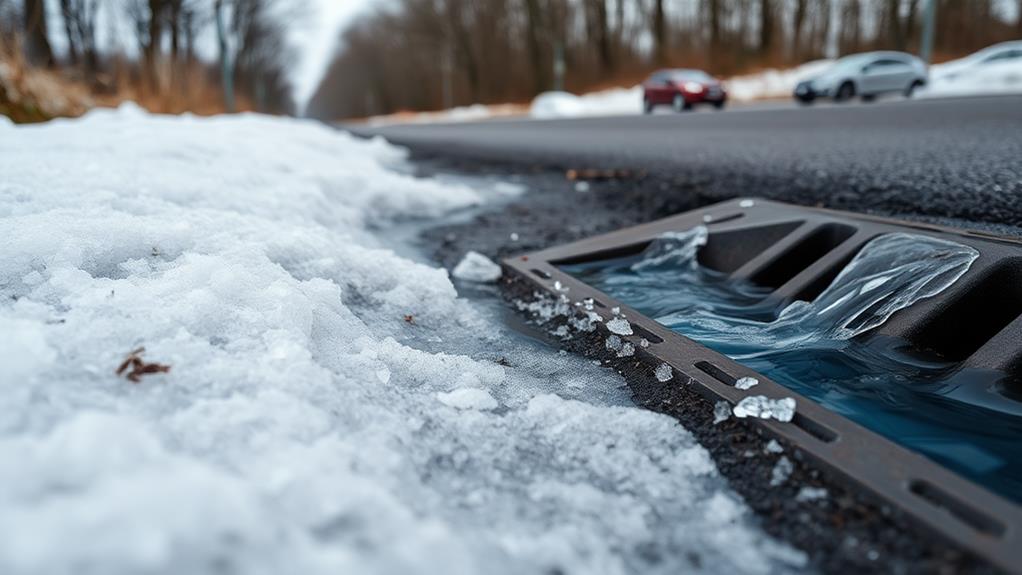
When you use salt for de-icing, you’re not just melting snow and ice; you’re potentially contributing to significant environmental issues. The runoff from salt-treated surfaces can lead to water pollution, damage soil and vegetation, and disrupt wildlife habitats in surrounding areas. To better understand the environmental impact of salt runoff, consider the following table, which outlines some key effects on different ecosystems:
| Ecosystem | Short-term Effects | Long-term Consequences |
|---|---|---|
| Aquatic | Increased salinity, fish stress | Algal blooms, species decline |
| Terrestrial | Plant dehydration, soil erosion | Reduced biodiversity, soil infertility |
| Urban | Corrosion of infrastructure | Groundwater contamination, structural damage |
Water Pollution Effects
The environmental toll of salt runoff extends far beyond the winter months. You’ll find that water pollution is a significant consequence of excessive road salt use, affecting our shared ecosystems and water resources.
As salt-laden runoff makes its way into streams, rivers, and lakes, it alters the chemical composition of these water bodies, potentially harming aquatic life and vegetation. You’ll notice that increased salinity can disrupt the osmotic balance of freshwater organisms, leading to reduced biodiversity and altered food chains in our local waterways.
Moreover, you’re likely to observe that salt contamination can impact groundwater quality, potentially affecting drinking water sources for your community. As salt concentrations rise, you may experience changes in water taste and increased corrosion of water infrastructure.
It’s crucial to understand that these effects can persist long after the snow has melted, as salt accumulates in soil and continues to leach into water systems. By acknowledging these impacts, you’re taking the first step towards collectively addressing this environmental challenge and safeguarding our shared water resources for future generations.
Soil and Vegetation Damage
Salt’s impact on soil and vegetation is far-reaching and often underestimated. When you use salt for de-icing, you’re inadvertently introducing harmful chemicals into the surrounding environment. As salt-laden runoff seeps into the soil, it alters the soil’s chemical composition, leading to nutrient imbalances and reduced fertility. This can have devastating effects on plant life, causing stunted growth, leaf damage, and even death in severe cases.
The damage isn’t limited to roadside vegetation; it extends to nearby lawns, gardens, and natural habitats. Here’s how salt affects soil and vegetation:
- Increases soil salinity, making it difficult for plants to absorb water
- Disrupts soil structure, leading to compaction and poor drainage
- Inhibits nutrient uptake, causing plant deficiencies
- Damages plant tissues, particularly roots and leaves
You’ll notice that trees and shrubs near heavily salted areas often exhibit signs of stress, such as browning leaves, early defoliation, and reduced growth rates. Salt spray from passing vehicles can also coat plants, causing direct damage to foliage. To mitigate these effects, you should consider alternative de-icing methods or use salt sparingly, applying it only where absolutely necessary.
Wildlife Habitat Disruption
Wildlife habitats bear the brunt of salt runoff‘s far-reaching consequences. As you ponder the environmental impact of de-icing techniques, it’s pivotal to understand how salt affects the delicate balance of ecosystems. When salt-laden runoff enters streams, ponds, and wetlands, it alters the water chemistry, potentially harming aquatic plants and animals. You’ll find that amphibians, particularly vulnerable to changes in their environment, may experience reduced reproduction rates and developmental issues due to increased salinity.
The ripple effect extends to terrestrial wildlife as well. Birds and small mammals that rely on aquatic food sources may struggle to find suitable prey, leading to population declines. Salt accumulation in soil can also impact the growth of vegetation that serves as food and shelter for various species. As habitats become less hospitable, you might notice shifts in animal migration patterns and reduced biodiversity in affected areas.
To mitigate these effects, it’s imperative to contemplate alternative de-icing methods or implement salt management strategies that minimize runoff. By doing so, you’ll contribute to preserving the intricate web of life that depends on healthy ecosystems, ensuring a more sustainable approach to winter road maintenance.
Frequently Asked Questions
How Do Different Types of Salt Affect Vehicle Corrosion Rates?
You’ll find that different salts impact your vehicle’s corrosion rates differently. Calcium chloride’s the most aggressive, while magnesium chloride’s less damaging. Rock salt falls in between. It’s important to protect your ride from all types.
What Alternatives to Salt Are Effective for De-Icing in Extreme Cold?
You’ve got options beyond salt! Try sand, gravel, or kitty litter for traction. Chemical de-icers like calcium magnesium acetate work well. For eco-friendly choices, consider beet juice or cheese brine. You’ll be part of the solution!
Can Salt Be Reused or Recycled After Snow Melts?
You’ll be glad to know you can reuse salt after snow melts! Simply collect the runoff, filter out debris, and let it evaporate. The remaining salt can be used again, saving you money and reducing environmental impact.
How Does Salt Application Timing Affect Its Effectiveness in Preventing Ice Formation?
You’ll want to apply salt before ice forms for the best results. If you wait until after, it’s less effective. Timing is key! Apply it when temperatures are dropping, and you’ll be part of the ice-free club.
What Are the Long-Term Effects of Salt on Concrete and Asphalt Surfaces?
You’ll notice salt’s long-term impact on your surfaces. It’ll corrode concrete, causing cracks and spalling. On asphalt, it’ll break down the binder, leading to potholes. We’re all in this together, facing these challenges to our roads.


